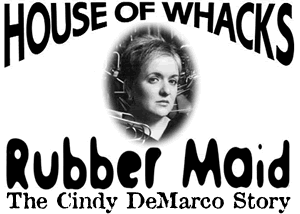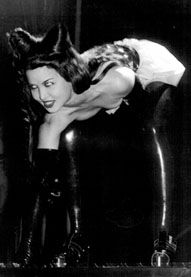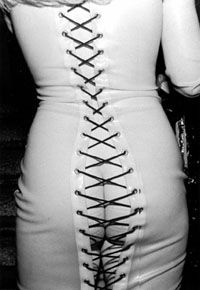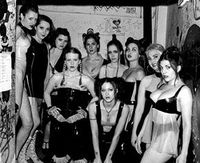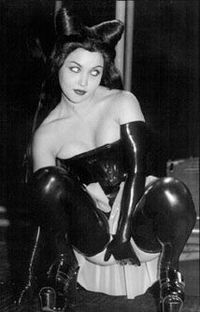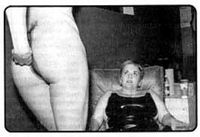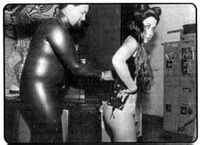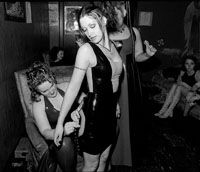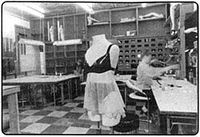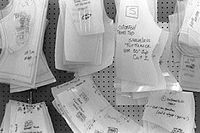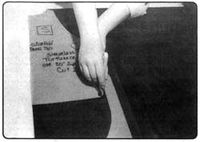House of Whacks
House of Whacks article
- Copyright (c) 2000 ChicagoReader, Inc. All rights reserved. Used with permission.
- By Cheryl Ross with photographs by Marty Perez
The people arriving at Metro are wearing leather face masks, angel wings, devil horns. A suburban couple in their late 40s-he's in a cotton shirt and shorts; she's in a classic dress and pumps-waltz inside carrying a gym bag and head for the rest rooms. When they emerge he's in a red rubber muscle T and she's got on a short red rubber dress and knee-high boots with five-inch heels-she calls it her "whore wannabe" look.
Ken Melvoin-Berg, an off-duty Metro security guard who says he's also a "full-time" psychic and co-owner of a "metaphysical" bookstore, arrives in a leather hood, chain-mail shirt, and spiked leather G-string.
Cindy DeMarco, the party's hostess, tells him he can't go in. "It's illegal to show your butt in public."
He seems stunned. "Are you being serious?"
"I'm dead serious."
"I'd better hide my ass."
"You'd better do something with it."
Melvoin-Berg leaves but soon returns, still wearing the G-string but with a pair of rubber shorts underneath.
It's a Saturday night in late August, the sixth annual Ball of Whacks, DeMarco's party for the "latex, leather, bitch, butch, kinky drag, fetish fantasy, glam, Goth, superhero, TS [transsexual], TV [transvestite], PVC, or uniform" crowd. DeMarco-who's wearing a long black rubber dress with see-through side panels, straps, and back, all polished with STP and sprayed with silicone-is offering her guests dancing, drinks, a latex fashion show, and a "human suspension" act, guys dangling from hooks in their flesh. "I've always taken it upon myself," she says, "that I should show people the things they wouldn't see otherwise."
DeMarco is the owner of House of Whacks, which opened six years ago as an imported-fetish-clothing shop and erotic art gallery. Since then it has metamorphosed into a latex-wares boutique that sells almost exclusively DeMarco's own fashion line, House Wears. According to DeMarco, it's now one of the country's biggest producers of wholesale latex clothing.
When the shop opened, few venues around the city threw parties for the fetish crowd, so DeMarco started hosting shindigs at her shop almost every month to create demand for her wares. But business is now so good she's cut back to one big blowout a year.
At this summer's Ball of Whacks the suburban couple is dancing amid a mostly white crowd that ranges from kids right out of high school to the retirement set. The wife says she's impressed by the number of other middle-age couples at the ball, then points to DeMarco. "You know, she's not exactly 20 years old anymore either and a size two. So it has a broad appeal for lots of people for lots of different reasons, which is kind offun."
The couple won't reveal their names, but the wife does say she's a health-care worker whose peers perceive her as "very conservative, hardworking, extraordinarily straight, and very boring." She says they'd drop dead if they saw her tonight. The husband says he's "in transition-at home raising the kids," three teenagers who apparently don't know about these nighttime escapades. "We've dropped hints," the wife says, "but they don't want to know." She says that she and her husband have been married nearly 23 years and that their clandestine outings helped put the spice back into their marriage. "You sort of play different roles, and we love it," she exclaims. "Don't we love it, dear?"
"Yeah," he answers flatly. "It's more my wife's passion and interest. But we have a lot of fun together."
In a dressing room Suzette Schwent is parading around in the House Wears design she'll be modeling in tonight's show, a see-through rubber leotard with a slither of black paneling covering her breasts and privates. She remembers shopping as a teen at a suburban mall with her mom and trying on a rubber dress. "You love the smell, the feel-everything about the latex," she says. "It feels like a second skin. It's like a hug. It's very warm. The only time it's uncomfortable is when you unzipper it at the end of the evening to hop in the shower, and then you get a whoosh of cold air. But that's for one second, and it's fleeting-and you've already had your fun."
Schwent's boyfriend, Michael Gallagher, a construction contractor, is lounging on a couch in jeans, a T-shirt, and Doc Martens. Asked what he thinks of Schwent's taste for rubber clothing, he says, "To each his own. Whatever they want to do, they want to do it. But it's not alternative anymore. It's mainstream. They're all followers. They're not leaders."
Ivy Nguyen, a petite 23-year-old who's come all the way from Oklahoma, is hanging out in the dressing room attired in a metal bikini top with pointed nipples, a rubber garter, satin thong, rubber stockings, and heels. She says she's worshiped DeMarco for years and considers her shop "one of the best manufacturers of fetish wear you can get-it's like the DKNY of fetish."
Nguyen says she became fascinated with the fetish scene after she saw Nine to Five when she was 12. "The part where Dolly Parton and Lily Tomlin string their boss up in a harness and put him on a garage door opener-I loved it! I just liked the idea of women dominating men." She and her immigrant parents manufacture computer circuit boards at a plant in Oklahoma City. Her parents don't know about her nighttime life, but Nguyen wants to open her own fetish shop someday. She says the fetish balls in Oklahoma are "very, very low-grade" affairs attended mostly by gay men who use homemade restraints and clothing. "It's less fashion and more of a lifestyle."
Around 1 AM the Dallas-based group Traumatic Stress Discipline begins its act. A guy with 20 hooks jabbed into his flesh, from his upper to his lower body, hangs spinning in midair from ropes attached to the hooks. Two men on each side of him dangle from hooks in their backs. The 400 or so spectators sway, cheer, or just watch. On the dance floor a woman leans over and spreads her ample cheeks while another partygoer gives them a slow, hard whacking. The suburban couple heads for the door. "It's not my thing," the husband says, laughing.
At about 2 AM the House Wears fashion show begins. The women prance about the stage in rubber outfits, everything from a Victorian corset to a short black skintight dress with see-through side panels. The crowd cheers. DeMarco and her staff take the stage, and DeMarco bows. Later her employees present her with a dozen red roses.
House of Whacks, at 3514 N. Pulaski, is in a storefront on a block with a dental office and laundry and across a busy street from a funeral home. The windows are covered with wood, and the whole facade is painted black. The only sign that the shop is here is the abbreviation HOW on the mailbox. You have to ring a buzzer to get in. Inside the small showroom are mannequins in rubber wear, a display case with House Wears catalogs and flyers from the annual ball, and two large dressing rooms behind black rubber curtains.
On one clothing rack hangs a pair of what DeMarco calls "clit-stim"panties, red rubber undies featuring bumps along the crotch ($49). She saysthat item is available only by special order, that her line focuses more onfashion. Other racks hold garments such as transparent thong underwear formen with a front zipper ($40) or without ($35), muscle-man T-shirts with azipper ($79), women's flared short skirts ($99), and cat suits ($339). Most of the items are two-tone, often black with pearlized panels of blue, pewter, purple, red, or green.
DeMarco is wearing an above-the-knee tank-top dress in black cotton. She admits that most of the things in her closet at home are black cotton, though she does love the way rubber feels. "Like a good pair of boots makes you feel, but different," she says. "Because with rubber you also have this physical thing going on. It's more purely exhibitionism. I like to dress up in it and look good. But now the shop has become so much work that it's so rare that I get to do that."
She has one large but difficult-to-read tattoo that looks like an intricate piece of jewelry on her back; on close inspection it spells "scrutiny." "I designed it so that you would have to scrutinize it to read it," she says. "I wear it because I have to bear it every day of my life-so I can literally bear it. I can bear it on my back, but I can bear it in my business or however. Everything I do is scrutinized."
DeMarco offers around 100 designs in numerous colors and in sizes ranging from extra small to extra-extra large. Most of her sales come through her catalog or through her Web site. Almost all the clothing is made to order. "People get really upset when they call and want, you know, a purple cat suit in a size medium," she says. "And they're like, 'You don't have it?' No, we have to make it."
She also offers made-to-measure services for customers who aren't standard sizes, and she recently started doing custom designs. Two of her newest employees are costume designers; she'd never before hired staff who had any design training because she thought it would be a hassle to retrain them-she learned what she knows through trial and error.
DeMarco opens her doors to the public one day a month and by appointment, with a $100 deposit. (The business is listed in the phone book under House Wears not House of Whacks because, she says, "I don't want to get wankers.") She limits her hours because it's an ordeal to open the store. Mannequins have to be dressed and polished with STP. Every outfit that's tried on must be repolished to remove fingerprints and smudges. And customers who want a custom fit or design require a lot of personal assistance.
Most clients are between the ages of 25 and 55, and at least 60 percent of them are men. "Here's the tricky thing," DeMarco says. "A lot of the men are cross-dressers, so we sell about the same amount of men's as women's clothes-maybe more women's." She says many customers are business owners, but she's also seen doctors, lawyers, plumbers, truck drivers, and accountants. "They're usually people who are making some kind of decent money, because it is not a cheap hobby.
Ninety-five percent are white. "As much as I love my customers, I have to attribute that to our uptight society," says DeMarco, who's mostly Italian and Irish. "The same guys that are making corporate decisions, CEOs, are the same ones who are going to dominatrices to get a spanking. These people who are really nasty during the day are the ones who are going to the dominatrix's at night to somehow rationalize their behavior. But also I think white people are really uptight about sex in general-more so than like anyone." Then she points out that many House Wears customers buy her clothes to wear to parties, clubs, dinner, or the theater. One woman bought a black rubber dress to wear to the opera.
No one with a latex fetish has ever worked at the House of Whacks. "It wouldn't work," DeMarco almost screams. "They'd be sidetracked. I've got like slaves that call up, and they're like, 'I just moved here. I'm slave Bob from New York, and I was wondering if you could use any help.' I'm like, 'No, I'm sorry. Thank you very much.'" She laughs. "The more you want it, the less you're going to get it! The slave mentality is-if you're a slave technically you should go to a dominatrix and pay. And some of these slaves are cheap-you can ask dominatrices. What they'll do is they'll offer to do stuff because they don't want to pay. And that's a whole other world that I am really not a part of."
DeMarco says she's also had calls from slaves who want to start sexual conversations. "'Mistress so-and-so says I have to buy blah, blah, blah, blah for her.' I'm like, 'OK, fine. What size?' I won't get into their head. Sometimes that's what they want, but that's not why I won't. I won't because I am in the retail-clothing business. I'm not going to do it without getting paid $100 bucks an hour like the dominatrix does."
When DeMarco, who just turned 35, was three her parents moved the family from their Humboldt Park two-flat to a house in Northlake. Her father, a truck driver, and her mother, a part-time waitress, divorced about two and a half years later. DeMarco and her brother were sent to live with their mother's parents in Wisconsin while their mother worked and took college courses in accounting.
About a year and a half after the divorce, when DeMarco was about seven, she and her brother returned to their mother, who'd moved back to the city, and for the next five years lived with their mother during the school year, going back to their grandparents in the summer. Her mother was constantly moving, and each fall DeMarco found herself in a new school, trying to adjust to a new group of kids. When DeMarco was 12 her mother settled just a block and a half away from the storefront DeMarco would later turn into the House of Whacks. "I used to come to this store when I was a kid, when it was a hardware store," she says. "I was also in here when it was a flower shop, running over for last-minute Mother's Day flowers."
DeMarco had a wild streak even then. She recalls that in eighth grade she helped persuade most of her class to skip a half day because the school wouldn't allow them to have a party. About 20 kids went to one of their parents' houses, got into the family liquor cabinet, and got caught. "I really don't think I pioneered the whole movement, but for whatever reason, the principal did," DeMarco says. "I just remember my mother saying, 'Why do you always have to be a follower? Why can't you be a leader?' That stuck in my head. I was like, 'I'm not a follower. Did you miss what just happened here?'"
At Lane Tech DeMarco studied commercial art and graphics. She also began working-selling hot dogs at a fast-food joint, filing for the printing company where her mother worked, answering phones for another printing company. Her friends tended to be the unpopular kids, who saw themselves as outsiders too. "I was always getting harassed for wearing stovepipe black pants and new-wave-whatever," she says. "I didn't necessarily want to look different, but I always wanted to just be what I wanted to be." She also got harassed because she had large breasts. Boys yelled at her in school, and men made remarks when she walked down the street. She would cross the street just to avoid them, and when she was 18 she bought a car largely so she wouldn't have to walk in public so much (she's since had breast reduction surgery).
DeMarco got a small state grant to go to Wright College, and she took outside classes in such things as graphics. She also went on working part-time, answering phones and making appointments at a hair salon, taking care of a multiple-sclerosis patient, and teaching aerobics.
On vacation in London in 1984, DeMarco bought some punk clothes, and when she wore them back in Chicago people chased her down the street to find out where she'd found them. "It was nothing you didn't see here ten years later," she says, "but you sure weren't seeing it then." It occurred to her that she could import and sell the clothes, and in 1985 she and her friend Brian Cathers went to London to buy more. They sold their finds out of Cathers's Wrigleyville apartment, then in 1986 they opened a weekend-only boutique, Dressed to Kill, at Belmont and Broadway. They sold some rubber clothes, but mostly they sold vinyl as well as items such as bondage trousers and "political-statement-type T-shirts-your basic radical sort of clothing.
She and Cathers managed to book a few fashion shows at Limelight, where DeMarco was then working as a mail room manager and publicist, and people later came by to check out the shop. The money they made paid for partying and clothes-"which is all we really needed," says DeMarco, "because we still had our full-time jobs."
They moved to a storefront at Broadway and Patterson in the summer of 1987, but DeMarco didn't like that it was open to anyone and everyone. A lot of people, she says, "acted like idiots. They can't just come in and look at the clothes. They have to act like morons and impress their friends by yanking on the clothes." Then Cathers got hit by a car and was laid up in the hospital. In December the shop closed. "It was like Sid and Nancy," DeMarco says. " It was very intense while it went on and then it ended rather abruptly."
By then DeMarco's job at Limelight included party promotions, and she threw her first fetish party. She left that job not long before Limelight closed down, on New Year's Eve 1988, then held several other jobs at clubs where she organized fetish parties. She worked as promotions director for the Riviera, did freelance promotions at Clubland, sold printing services to businesses, was a production manager for a printing company, and managed an adult clothing and toy shop. She also did promotions for the China Club. "I think they just had me there so they'd have a girl working there," she says. "I found out that the security manager was making like twice what I was making, and he was doing a quarter of the work. It was just really sexist, to the degree that one day I yelled at the guys, 'Do I have to put on a strap-on to get you people to listen to me?'"
She says she wound up doing a lot of drinking and "self-medicating." Finally, in the summer of 1992, a psychiatrist put her in a hospital for a couple of days, and she learned that she suffered from bipolar disorder. "It was just to the point that it was too much," she says. "The crashes were way worse than the highs. So I was like, you know what? I've got to do something." She quit the club. "They called me and they're like, 'You can't do this-we have this big show.' And I said, 'I'm doing this!'"
DeMarco went back to one of the printing companies as an estimator, the person who figures the cost of a printing job. Then the owner died, and she suddenly found herself reporting not to the CEO but to a middle manager-something she claims no male estimator had to do. "They were trying to get rid of me," she says. "I was like hysterical, I was like crying in the bathroom. I couldn't go to work. I was really a mess. I'd call in sick, and they'd yell at me that you can't call in sick unless you speak to your supervisor."
DeMarco's mother, by this time the personnel director for another printing company, advised her daughter to let the company fire her, and in early 1993 it did. She threatened to sue but settled with the company out of court; the money "wasn't any great shakes."
By then she'd decided she'd never work for anyone else again if she could help it. She knew two businesses well enough to tackle on her own, so she tossed around the idea of opening either a printing company or a fetish shop. She settled on the latter. "Men are more polite [in the fetish world] because they have more respect for the women, she says. "Because of the dominant female figure maybe?" She also thought it would be a way to turn the tables on all the men who'd been jerks to her and who'd yelled obscenities at her. She saw herself laughing all the way to the bank.
The name House of Whacks came to her in a dream. "I thought, it's perfect, because it's house of, like House of Chanel."
In March 1993 DeMarco flew to London and returned with a bundle of outfits bought on credit and several potential business deals with latex-clothing manufacturers. Using cash advances from eight credit cards, she rented a small space at 1800 W. Cornelia, and on July 1 she opened for business. She planned to do all the work, though her mother had agreed to help with bookkeeping. In addition to the rubber clothing, she offered works by local fetish artists and items such as restraints, handcuffs, biting bits, and gags. The store was open only on Saturdays, but for the opening DeMarco threw three days of parties and fashion shows featuring store merchandise. She would continue throwing parties almost every month, pulling in fetishists and the simply curious.
DeMarco put her graphics skills to use designing a catalog of black-and-white photos of models wearing her clothing in provocative poses. On the first page was her riff on "So You Want to Be a Rock 'n' Roll Star," and the photos illustrated the song's lyrics. "If you know the song and sing it in your head, the pictures tell the story," she says. "But nobody got it but me. She sold hundreds of copies for $10 each.
On the store's first anniversary DeMarco threw the first Ball of Whacks at Metro. She recalls that about 200 people came for the music, staged S and M scenes, and silent auction of merchandise she and other businesses had donated. She took in a few thousand dollars, some of which was donated to a group of people in London who'd been arrested for having consensual S and M sex in their homes.
A month later DeMarco was at her shop waiting for a friend to give her a ride to a wedding reception. At the last minute the friend called to tell her that a man she'd never met, Ken Fank, would be picking her up instead. DeMarco told Fank, a forklift operator for Consolidated Freightways, that she liked hanging out at the Chicago Eagle, a gay leather bar where one of her friends worked, and asked him if he wanted to go with her that night. He said yes. "That was the first test that he passed," DeMarco says. "We just hung out that night, and then we went on one date for Indian food. And that was it." A week later they were a couple.
Several weeks later Fank's leg was shattered in a motorcycle accident, and he landed in the hospital for several weeks. DeMarco constantly sat by his bed, often working on her business. When he was discharged he moved into her apartment.
The next spring DeMarco and Fank were picking up her depression medication. Fank pointed out that she'd pay much less for it if she were on his medical insurance. "I said I know, and we were like, hey, we should just get married," she recalls. "And that's how it happened-because of insurance. But it was funny. When I told my doctor, he goes, 'People only started marrying for love in the last 100 years, Cindy. It makes total sense.'"
They decided to get married on the same day as the second annual Ball of Whacks. DeMarco says, "I was like, I'm not throwing two parties like this in one year."
They were married by the friend who'd sent Fank to give DeMarco a ride, who had a mail-order certificate allowing him to officiate. At the wedding half the room was in traditional clothes, the other half in fetish wear. Fank wore all rubber-black tux, white shirt, and red vest. DeMarco wore a Marie Antoinette wig and rubber-a red-and-black corset, a hoop-wire miniskirt, a train, thigh-high red boots, and a jacket. The wedding clothes were all her own creations. She and Fank exchanged black rubber wedding bands, and they briefly appeared at the ball that night.
House of Whacks was doing reasonably well. DeMarco had dropped the restraints, handcuffs, bits, and gags. "You can get those anywhere," she says. And she'd cut back on the erotic art because it wasn't selling. But the high-end imported clothing was, and she needed more space. By the spring of 1995 the business moved to 4017 N. Damen.
To attract new customers, DeMarco kept trying new things. Some ideas, including rigging up a television to show fetish videos in the store, were quickly dropped. "We'd get like geezer perverts in there who would just sit and watch. It was like, 'OK, we've got to stop the video thing.'" She also put out a second House of Whacks catalog, "An Adult Garden of Perv Verses...and other Nursey Rhymes." The cover showed a "nurse" in a rubber zip-front dress, mask, apron, stockings, and heels. The back cover showed her from the back, standing between the legs of a "patient" on a stirrup table. Inside were photos that showed, among other things, a man in a burgundy zip-front dress and platform shoes with the caption "Mary, Mary, quite contrary" and a blindfolded, rubber-leotard-clad woman with her arms and feet tied above the caption "Good night, sleep Tight." DeMarco sold thousands of the $20 catalogs.
She now had a part-time sales associate, a full-time "boy Friday, and a full-time office assistant (Fank tried helping make the clothes, but he didn't have a knack for it). All the help gave her time to think about new directions for her store. Unhappy that she couldn't always provide customers with the clothes they wanted or get them on time, she decided to try her hand at designing and making her own rubber-clothing line.
DeMarco had only a liberal arts degree and no one to show her how to make the clothes. She started testing things to figure out how they worked. "How can I apply this glue? How can I be sure that this won't fall apart? How can I cut a pattern? I don't even know how to make a pattern."
A rubber-clothing manufacturer agreed to tell her what glue to use-what she now calls her "superspecial secret-sauce glue"-and how to use it if she would help the company produce a catalog. But the company used a thicker latex than she did, and when she used its gluing method with her material she wound up with bumps. Eventually she found a way to apply it with foam brushes. The manufacturer also showed her how to cut rubber with large upholstery shears, but that method didn't work for DeMarco either, because the shears made nicks that could lead to tears. She finally started using a rotary cutter. "I don't think I'm a pioneer in that," she says. "I'm sure everyone in Europe has been doing that for years, but I had to figure it all out for myself." She also developed hard plastic pattern templates because her paper patterns kept getting sliced up.
DeMarco sold her House Wears designs for less than her imports, figuring that if they cost less people would buy more. She was wrong. They bought about the same number of items they had in the past, but instead of spending $250 they spent $100. Rather than raise prices, DeMarco decided to create and sell more of her own designs.
DeMarco says she and her employees were making her line in "really tiny spaces, all on top of each other." In spring 1996 they moved to the storefront on Pulaski, which had double the room of the Damen shop.
About this time DeMarco discovered she was pregnant. She decided she had to start using her time-and her employees'-better. She'd stopped carrying the erotic art and the outside clothing lines, though she still sold accessories-gloves, stockings, hoods-from a Denmark-based company. Now she dropped the full-blown catalogs in favor of a one-page brochure showing about 20 of her designs, and she stopped throwing the monthly parties. But that summer she did have a third annual ball.
In December Maxine "Max" DeFank was born. About a week later DeMarco went back to work.
In 1997 she began hitting the trade-show circuit in an effort to build up a wholesale clientele. She had two new assistants constructing, polishing, and packing clothes, and one of them, Edith Muniz, had an eye for what would sell. DeMarco recalls a loose-fitting shirt she'd designed. "Everybody does all their latex supertight and I was like, it's such pretty fabric and such nice material-it drapes and hangs so well. Edith came in to work. I held it up and I go, 'What do you think?' And she's like, 'You are so going to sell that shirt.' And she was so right. A lot of big guys want to wear something but don't want to look fat or be uncomfortable. Little tiny guys like that shirt."
By early 1998 her business was only breaking even. She says she was so busy keeping the shop afloat, teaching her new employees how to make clothes, and building up wholesale accounts that she didn't have time to develop her line, which was then at about 60 pieces. Still, by that fall she'd jumped from 15 wholesale accounts to around 50, and her store began to turn a profit.
DeMarco is now doing so well that she has almost completely paid off all the credit cards she used to start her business. This year she added 35 designs to her collection, bringing her basic line to just under 100.
All the clothes modeled at this year's ball were DeMarco's concepts, but her employees helped develop them. "Cindy would come up with what she wanted," says Erin Gardner. "I would go draw it up and say, 'Is this what you're looking for?' We would sit down and talk about it. She goes, 'I want to do a suit. Here are pictures.' I'd bring her research material, and then I would go home and sketch it out for her. She would go yes, no. We would make changes. Then Jess [Kelley] would pattern, figure out how it would work best.
Business has been so good that DeMarco decided to hire a service to take calls when her shop was closed, but two companies refused to take her as a client. She thinks they were scared off by her Web site and her merchandise. She put a long, detailed message on her answering machine.
One afternoon Fank brings Max, who's nearly three years old, to the shop. She bounds in wearing a red dress sprinkled with bumblebees and licks her mother's shoulder. Her mother laughs. "Since I got married and had the baby," she says, "it's pretty hard to be depressed."
Frank, who works nights and watches Max during the day, frequently brings her to visit DeMarco. To the little girl the latex clothes are things out of fairy tales. "She sees the ball gown and goes, 'Cinderella dress!'" says DeMarco, adding that she'd never dress her child in the kind of clothes she sells. Then she says, "But just think of the great Halloween costumes she's going to have when she's older. When she's older."
In 1997 DeMarco's annual ball was on a boat that cruised the Chicago River, and in '98 it was at the Park West. Plenty of other venues around the city are also now open to having fetish functions. "There's this dungeon, that dungeon, this gallery, that gallery," DeMarco says. She thinks she can take some credit for the change. "There are things to go to now, so we sort of accomplished what I wanted to. I wanted places for people to go to wear the clothes."
Asked whether she thinks the latex crowd has become mainstream, as Suzette Schwent's boyfriend claimed, DeMarco says indignantly, "Look at what we have to go through to get them all together for the ball-God! They come from Oklahoma City, New York, Japan. Somebody was also in from England because they heard about it."
But she wouldn't mind if latex became mainstream. "I want to start sending things out to theaters," she says. "I want to send stuff out to record labels. Cirque du Soleil should be wearing our clothes. Ice skaters should be wearing our clothes. There's all kinds of performance-type areas, theatrical or whatnot that our clothes would fit. It's fun to wear to clubs and this and that and the other. I really want to take rubber out of the gutter and put it on the street."
See also [ House of Whacks (closed) ]
Copyright (c) 2000 ChicagoReader, Inc. All rights reserved.
Sources
Chat rooms • What links here • Copyright info • Contact information • Category:Root
